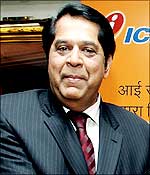|
|
| Help | |
| You are here: Rediff Home » India » Business » Report |
|
 K V Kamath, ICICI Bank CEO and Managing Director. | ||
| ||||||||||||||||||||||||||||||||||||||||||||
|
| ||||||||||||||||||||||||||||||||||||||||||||
Last Updated: January 14, 2008 16:48 IST
ICICI Bank, the country's biggest private lender, expects overseas business to account for at least one-fourth of its balance sheet in 2008 and is targeting a place among the world's top ten banks within five years.
"If there ever be an Ivy League of global banks, I believe, in 5-10 years, we have to have a few banks from China and a few from India in that league," ICICI Bank [Get Quote] managing director and chief executive officer K V Kamath told PTI in an interview.
"The target is that we will try to do it in less than five years. China has done it and their three banks are in the top ten. Three years ago, none of us would have given them any change of getting there," he said.
While attributing the current position of Chinese banks to the economic uptrend that started there ten years ago, he said, "Within six years, as an Indian bank [Get Quote], we should also enjoy similar change in attributes."
Kamath said he did not see slackening of India growth story for another 15 years and if the GDP grows at 10-11 per cent, banks and financial services sector should grow at a three-times multiple or about 30 per cent every year.
"If you look at that possibility you are really looking at doubling your size every three years. Then in six years, it should be a size where most Chinese banks are today -- in the top 10," said the head of India's most valued bank.
ICICI Bank's joint MD and chief financial officer Chanda Kochhar said the bank was already India's biggest in terms of overseas business and was looking at a contribution of at least 25 per cent from its international business in 2008.
Currently, global assets account for 22-23 per cent of its balance sheet, Kamath said.
Talking about the bank's international expansion plans, Kochhar said after getting a license in the US, it was not looking at merely foraying into other countries. "In each of the 18 countries we are present, we have a lot of deepening and widening to do. This can happen in many ways. For some it can be expanding the role of the branches," she said.
"Our overseas growth would be driven around three platforms - Indian retail customers, Indian corporate customers and our niche cost-competitive areas. As we get into the next year, our international side of balance sheet would be about 25 per cent of the total."
With more than $19 billion of overseas assets, ICICI Bank is the largest international bank in India, she said. ICICI Bank played a role in 88 per cent of total number of outbound merger and acquisition deals by Indian companies during 2007, while in terms of value of these deals, the share was 65 per cent, she said. The involvement was largest in terms of value and second-largest in terms of volume.
Indian companies would invest up to $700 billion over the next few years. While a major part of it would come from their own internal accruals equity issue, a large portion would be through borrowings in local and foreign markets.
"We saw this as a coming opportunity two years ago and we calibrated our skills to be able to take large market share in this business. We have strengthened our investment banking capability and also international capability, so that we can not only give them loans but also syndicate a large part of loans for Indian corporates," Kochhar said.
ICICI Bank currently ranks as a leading arranger of foreign currency loans for India Inc. This was an area dominated by foreign banks till some time ago, Kochhar noted. She said in India also ICICI Bank was looking to have a role in 25 per cent of the investment pipeline worth about $500 billion likely to come from the corporates in the next three-four years.
"Our current balance sheet is over $100 billion and we are talking of a little over doubling the balance sheet in the next three-four years," she said.
Kamath said 100 per cent growth was not the way to go for banking business, but even at 30 per cent growth the size would double every three years. There were also inorganic opportunities, he added.
When asked which other banks from India he expected in the global top ten, Kamath hinted at the country's biggest lender, the State Bank of India [Get Quote]. "At least one large government bank is clearly capable of entering into that league," he said.
"In China also, it is the government banks that have got into that league. I think any other bank will take time because I do not see the scaling-up that is required being done as yet elsewhere," he noted.
"Ten years down the lane, an Indian bank would have to be there. Our endeavour is to see how much quicker we would achieve that. . . One thing is sure that an Indian bank would reach that Ivy League," Kamath said.
| © Copyright 2008 PTI. All rights reserved. Republication or redistribution of PTI content, including by framing or similar means, is expressly prohibited without the prior written consent. |
|
|
| © 2008 Rediff.com India Limited. All Rights Reserved. Disclaimer | Feedback |